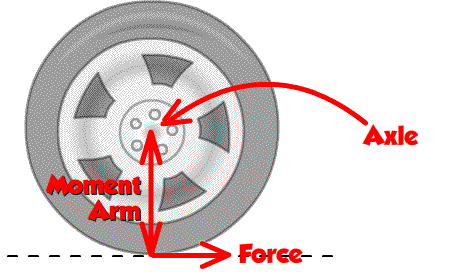To spin or rotate a car's tire. A force must be applied at some distance away from the axis the tire is
spinning around. This force must be pointing tangent to the rotation's direction. At least part of the force must be pointing tangent to the rotation.

the center of the rotation where the axle is located is called the "pivot" or the "pivot point." This ability of a force to cause a rotation is called a moment. The distance between where the force is applied and the axis of rotation is called a moment arm. To physicists a torque is another name for a moment and is the preferred term.
Torque is defined as the product of distance times the perpendicular component of force about a point in space.

Where  is the symbol for torque. It looks like a capital " T " with a tail to the right, but is lower case in size. The unit of torque is a "N•m." A, "N•m", is pronounced as if it were one word, "Newtonmeter." d is the symbol for the distance between the axis and the point where the force is applied. (Also called the moment arm.)
is the symbol for torque. It looks like a capital " T " with a tail to the right, but is lower case in size. The unit of torque is a "N•m." A, "N•m", is pronounced as if it were one word, "Newtonmeter." d is the symbol for the distance between the axis and the point where the force is applied. (Also called the moment arm.)  stands for the force that is 90° to the moment arm's vector.
stands for the force that is 90° to the moment arm's vector.
Torques cause the tendency to rotate.
To calcualte the value of a torque, multiply the magnitude of the perpendicular force times the distance between the pivot point and where the force is applied.
Any force that